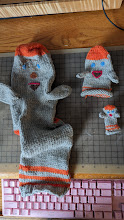Teaching using manipulatives
Listened to the latest episode of the CS Ed Podcast yesterday. It featured Colleen Lewis, of CS Teaching Tips fame talking about how she uses manipulatives. Much like Colleens session last SIGCSE on microteaching this episode made me both happy and sad.
Happy because it's awesome that Colleen is bringing attention to strong classroom teaching practices and she's sharing good stuff. Sad because these are things rarely talked about in teaching CS or college level teaching in general.
In the podcast Colleen mentioned manipulatives like physical pockets to represent variables and also discusses how she gets her classes on board. I recommend you give a listen (link).
The sad part is that using manipulatives is day one methods class stuff. I'm reminded of this clip from Mr. Holland's Opus - a teacher movie I really like:
A well prepared teacher has a tool belt full of options and isn't afraid to drag any of them out and use them as appropriate.
When I took math methods classes, manipulatives were day 1. Base 10 blocks, linking cubes, pattern blocks, cuisenaire rods, and more. From store bought to adapting free materials on hand. Of course, math manipulatives are frequently used in earlier grades by students for hands on exercises but they're also great for demonstrations and whole class activities and yes, even in High School or College.
While some teachers, particularly from what I've seen, at the college level, are gatekeepers, it's our jobs to make simple the complex. If diagrams help, we should use them. In class "games" - well why not, and certainly manipulatives. Colleen set up pockets for variables and in fact, on her site you can request a set but you can create your own. I mean, I'm sure all our schools have piles of those interoffice mail folders that don't get used anymore. Folders, or envelopes can also be used to teach message passing and networking concepts. How about a cardboard box for a literal "black box." Even props. I know that not everybody has custom made recursive sock puppets,

and few people have the production budget like say a class like CS50,but even lame makeshift ideas like drawing two dots for eyes on your hand can be used for positive effect.
For other ideas, how about having the class step through a program passing a ball around as a "talking stick." The student with the ball "executes" the line (or function or whatever). How about a physical stack for stacks or having the students line up for a list and then give them a "reference" to who's after them (on a postit for example) for a linked list activity. The ideas are out there if you look for them.
So don't be afraid to try out using physical tools, or manipulatives and if you've got an interesting one, I'm sure everyone would love to hear about it.
Circling back to the podcast and what Colleen shared, here are a couple of links to learn more:
- https://docs.google.com/document/d/1hk98trfOiU3CyPyJ07fGfql2mYaWf8qGZ0fS8FhDVwg/edit#heading=h.5i5t4kfuu5b5
- https://www.csteachingtips.org/3D
Enjoy.